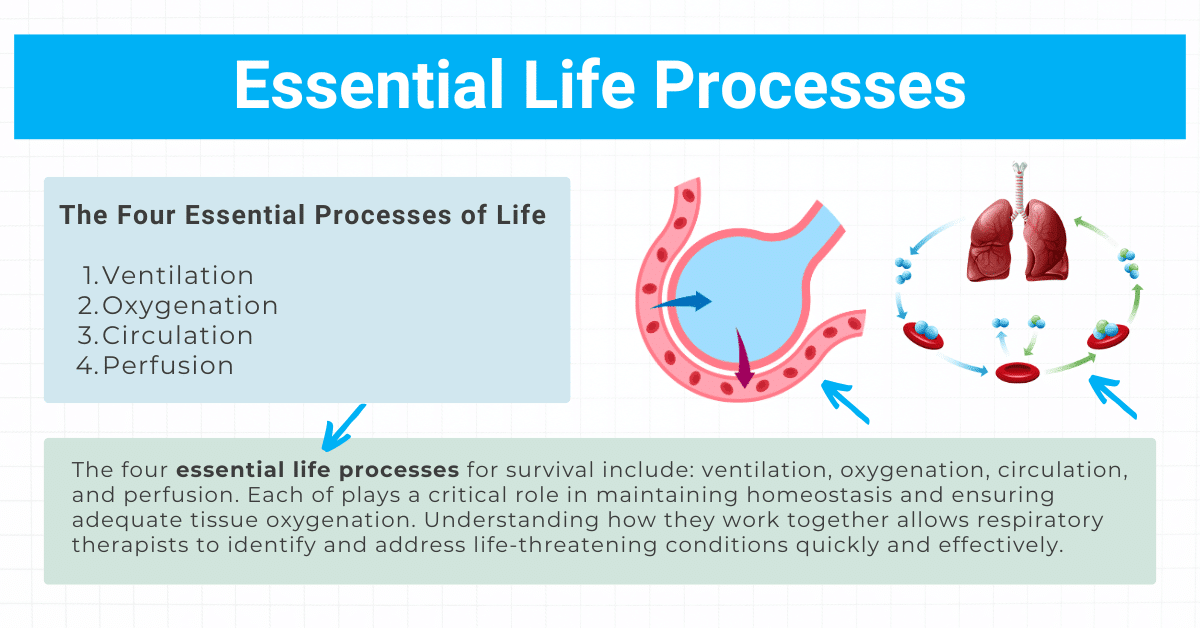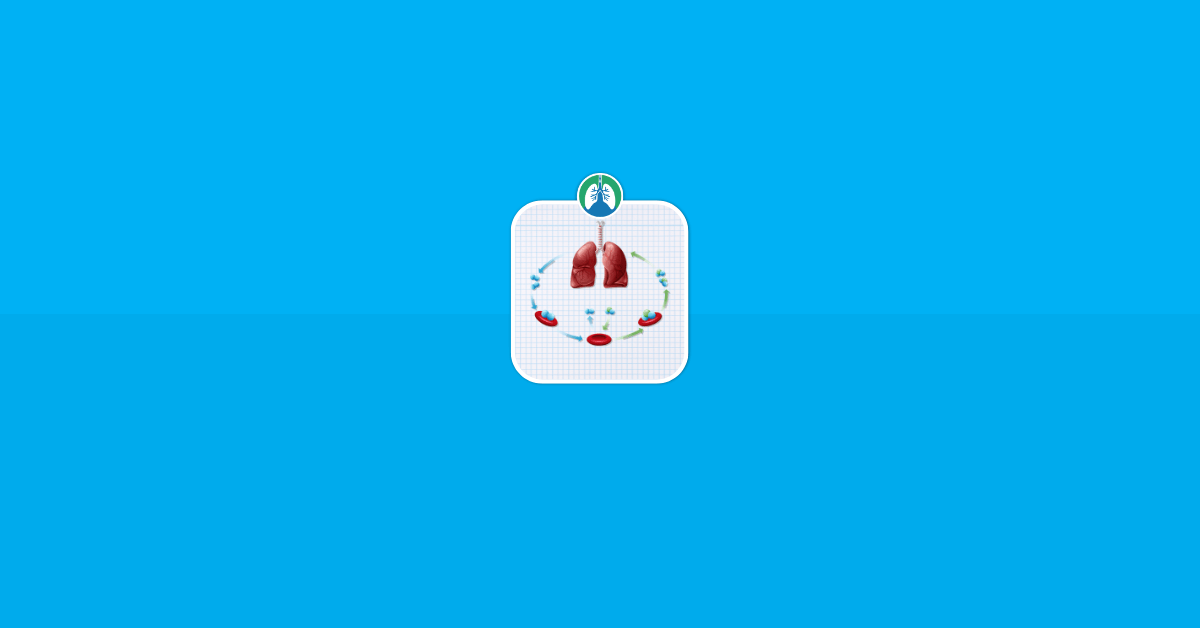As a respiratory therapist, your primary mission is to ensure that every cell in your patient’s body receives the oxygen it needs to function.
This responsibility requires a deep understanding of the four essential processes for survival: ventilation, oxygenation, circulation, and perfusion. These processes are interconnected, and any disruption in one can have cascading effects on the others.
In this article, we will explore the essential life processes in detail, discuss how to assess them through vital signs, and outline the priorities for treatment in emergency situations.
The Four Essential Processes of Life
- Ventilation
- Oxygenation
- Circulation
- Perfusion
Each of these processes plays a critical role in maintaining homeostasis and ensuring adequate tissue oxygenation. Understanding how they work together allows respiratory therapists to identify and address life-threatening conditions quickly and effectively.

1. Ventilation
Ventilation refers to the movement of air in and out of the lungs. It is the first step in the oxygen delivery process. Without adequate ventilation, oxygen cannot reach the alveoli, and carbon dioxide cannot be expelled from the body. Key indicators of ventilation include:
- Respiratory Rate: The number of breaths per minute. Abnormal rates (too high or too low) can indicate respiratory distress or failure.
- Tidal Volume: The amount of air moved in and out of the lungs with each breath. Reduced tidal volume may suggest restrictive lung disease or muscle weakness.
- Chest Movement: Symmetrical chest rise and fall are essential. Asymmetry may indicate a pneumothorax or other thoracic abnormalities.
- Breath Sounds: Listening to lung sounds can reveal wheezing, crackles, or absent sounds, which can help diagnose conditions like asthma, pneumonia, or atelectasis.
- PaCO2 (Partial Pressure of Carbon Dioxide): Measured via arterial blood gas (ABG), this value reflects the efficiency of CO2 removal. Elevated PaCO2 indicates hypoventilation.
- ETCO2 (End-Tidal Carbon Dioxide): Measured via capnography, this non-invasive tool provides real-time feedback on CO2 levels during exhalation.
2. Oxygenation
Oxygenation is the process of moving oxygen from the lungs into the bloodstream. It is critical for maintaining cellular function. Key indicators of oxygenation include:
- Heart Rate: Tachycardia may indicate hypoxia, as the heart works harder to deliver oxygen to tissues.
- Color: Cyanosis (bluish discoloration of the skin or mucous membranes) is a late sign of hypoxia.
- Sensorium: Altered mental status, such as confusion or agitation, can result from inadequate oxygenation.
- PaO2 (Partial Pressure of Oxygen): Measured via ABG, this value reflects the oxygen levels in arterial blood.
- SpO2 (Peripheral Oxygen Saturation): Measured via pulse oximetry, this non-invasive tool provides an estimate of oxygen saturation in the blood.
3. Circulation
Circulation involves the movement of oxygenated blood throughout the body. Without proper circulation, oxygen cannot reach the tissues. Key indicators of circulation include:
- Heart Rate: Both bradycardia and tachycardia can compromise cardiac output.
- Cardiac Output: The volume of blood the heart pumps per minute. Reduced cardiac output can lead to shock or organ failure.
4. Perfusion
Perfusion is the delivery of oxygen to the tissues. Even if ventilation, oxygenation, and circulation are adequate, poor perfusion can result in tissue hypoxia. Key indicators of perfusion include:
- Blood Pressure: Hypotension can indicate shock or inadequate perfusion.
-
Sensorium: Confusion or lethargy may result from poor cerebral perfusion.
-
Temperature: Cold extremities can suggest poor peripheral perfusion.
-
Urine Output: Reduced urine output may indicate renal hypoperfusion.
-
Hemodynamics: Measurements such as central venous pressure (CVP) and pulmonary artery wedge pressure (PAWP) can provide insights into perfusion status.
Effective respiratory and cardiovascular function depends on the balance of ventilation, oxygenation, circulation, and perfusion.
A disruption in any of these processes can lead to inadequate oxygen delivery and tissue hypoxia, resulting in serious complications. Continuous monitoring and timely interventions are crucial for maintaining optimal patient outcomes.
Assessing the Patient: A Step-by-Step Approach
When assessing a patient, it is essential to systematically evaluate each of the four processes. Here’s how to approach it:
-
Ventilation Assessment: Begin by observing the patient’s breathing pattern. Count the respiratory rate and note any irregularities. Listen to breath sounds using a stethoscope, and check for symmetrical chest movement. If available, review ABG results for PaCO2 and ETCO2 levels.
-
Oxygenation Assessment: Check the patient’s heart rate and SpO2. Look for signs of cyanosis or altered mental status. If ABG results are available, review the PaO2 level.
-
Circulation Assessment: Monitor the patient’s heart rate and rhythm. Assess cardiac output if advanced monitoring tools are available.
-
Perfusion Assessment: Measure blood pressure and check for signs of poor perfusion, such as cold extremities or reduced urine output. Review hemodynamic measurements if applicable.
Treating the Patient and Addressing Abnormalities
If you identify abnormalities during your assessment, immediate intervention is crucial. Here’s how to prioritize treatment based on the four processes:
-
Ventilation: If ventilation is compromised, ensure the patient’s airway is clear. Administer supplemental oxygen or mechanical ventilation as needed. Address underlying causes, such as bronchospasm or airway obstruction.
-
Oxygenation: If oxygenation is inadequate, increase the FiO2 (fraction of inspired oxygen) or adjust ventilator settings. Consider non-invasive ventilation or intubation if necessary.
-
Circulation: If circulation is impaired, administer fluids or vasopressors to support blood pressure and cardiac output. Address arrhythmias or other cardiac issues.
-
Perfusion: If perfusion is poor, optimize blood pressure and cardiac output. Ensure adequate fluid status and address any underlying causes, such as sepsis or hemorrhage.
Emergency Situations and Prioritizing Life Functions
In an emergency, the order of priority is as follows:
-
Ventilation: Ensure the patient is breathing.
-
Oxygenation: Ensure oxygen is reaching the bloodstream.
-
Circulation: Ensure blood is moving through the body.
-
Perfusion: Ensure oxygen is reaching the tissues.
Note: This sequence reflects the urgency of each process. Without ventilation, oxygenation cannot occur. Without oxygenation, circulation is futile. Without circulation, perfusion is impossible.
Common Challenges in Respiratory Care
As a respiratory therapist, you will frequently encounter issues with oxygenation. Hypoxemia (low blood oxygen levels) can result from a variety of conditions, including pneumonia, chronic obstructive pulmonary disease (COPD), acute respiratory distress syndrome (ARDS), and pulmonary embolism. Each condition requires a tailored approach to treatment.
For example, in COPD patients, oxygen therapy must be carefully titrated to avoid suppressing the hypoxic drive to breathe. In ARDS patients, low tidal volume ventilation and positive end-expiratory pressure (PEEP) are often necessary to prevent further lung injury.
The Role of Technology in Patient Assessment
Modern technology has revolutionized the way respiratory therapists assess and treat patients. Tools such as pulse oximeters, capnography, and advanced ventilators provide real-time data that can guide clinical decision-making.
For example, capnography can help detect early signs of respiratory failure, while advanced mechanical ventilators can deliver precise levels of breathing support tailored to the patient’s needs.
Final Thoughts
Assessing and treating patients as a respiratory therapist requires a thorough understanding of the four essential processes for survival: ventilation, oxygenation, circulation, and perfusion.
By systematically evaluating these processes and addressing abnormalities promptly, you can ensure that your patients receive the care they need to recover and thrive. In emergency situations, prioritizing these processes in the correct order can mean the difference between life and death.
As technology continues to advance, respiratory therapists will have even more tools at their disposal to provide high-quality care and improve patient outcomes. Remember, your role is not just about treating conditions—it’s about ensuring that every breath your patient takes brings them closer to recovery.
Written by:
John Landry is a registered respiratory therapist from Memphis, TN, and has a bachelor's degree in kinesiology. He enjoys using evidence-based research to help others breathe easier and live a healthier life.
References
- Sapra A, Malik A, Bhandari P. Vital Sign Assessment. [Updated 2023 May 1]. In: StatPearls [Internet]. Treasure Island (FL): StatPearls Publishing; 2025.
- Powers KA, Dhamoon AS. Physiology, Pulmonary Ventilation and Perfusion. [Updated 2023 Jan 23]. In: StatPearls [Internet]. Treasure Island (FL): StatPearls Publishing; 2025.

